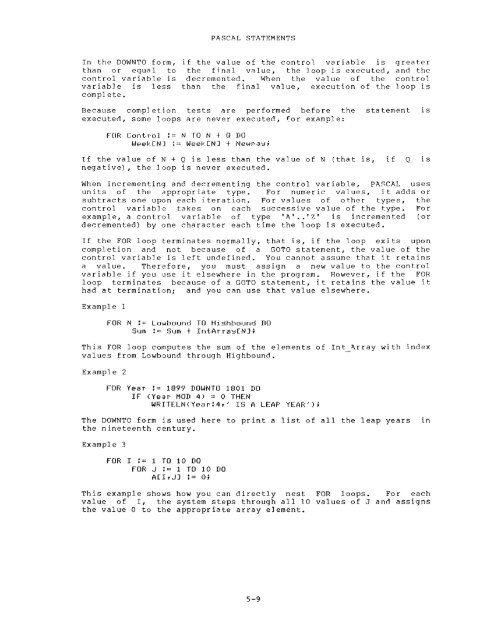TOPS-20 PASCAL Language Manual - Bitsavers
TOPS-20 PASCAL Language Manual - Bitsavers
TOPS-20 PASCAL Language Manual - Bitsavers
Create successful ePaper yourself
Turn your PDF publications into a flip-book with our unique Google optimized e-Paper software.
<strong>PASCAL</strong> STATEMENTS<br />
In the DOWNTO form,<br />
than or equal to<br />
control variable is<br />
variable is less<br />
complete.<br />
if the value of the control variable is greater<br />
the final value, the loop is executed, and the<br />
decremented. When the value of the control<br />
than the final value, execution of the loop is<br />
Because completion tests are performed before the statement is<br />
executed, some loops are never executed, for example:<br />
FOR Control := N TO N + Q DO<br />
Wpek r: N ] :::~ We (::)k [N] + Newpa~:I'<br />
If the value of N + Q is less than the value of N (that is,<br />
negative), the loop is never execut,ed.<br />
if Q<br />
is<br />
When incrementing and decrementing the control variable, <strong>PASCAL</strong> uses<br />
units of the appropriate type. For numeric values, it adds or<br />
subtracts one upon each iteration. For values of other types, the<br />
control variable takes on each successive value of the type. For<br />
example, a control variable of type 'A' •. '2' is incremented (or<br />
decremented) by one character each time the loop is executed.<br />
If the FOR loop terminates normally, that is, if the loop exits upon<br />
completion and not because of a GOTO statement, the value of the<br />
control variable is left undefined. You cannot assume that it retains<br />
a value. Therefore, you must assign a new value to the control<br />
variable if you use it elsewhere in the program. However, if the FOR<br />
loop terminates because of a GOTO statement, it retains the value it<br />
had at termination; and you can use that value elsewhere.<br />
Example I<br />
FOR N := Lowbound TO HiShbound DO<br />
Sum := Sum + IntArra~[NJ;<br />
This FOR loop computes the sum of the elements of Int_luray with index<br />
values from Lowbound through Highbound.<br />
Example 2<br />
FOR Year := 1899 DOWN TO 1801 DO<br />
IF (Year MOD 4) = 0 THEN<br />
WRITELN(Year:4,' IS A LEAP YEAR');<br />
The DOWNTO form is used here to print a list of all the leap years<br />
the nineteenth century.<br />
in<br />
Example 3<br />
FOR I := 1 TO 10 DO<br />
FOR J := 1 TO 10 DO<br />
A[I,JJ := 0;<br />
This example shows how you can directly nest FOR loops. For each<br />
value of I, the system steps through all 10 values of J and assigns<br />
the value 0 to the appropriate array element.<br />
5-9
















